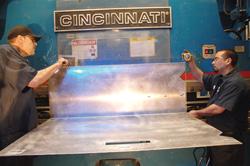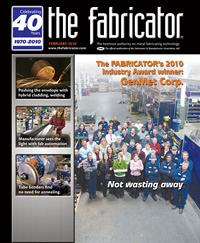Editor-in-Chief
- FMA
- The Fabricator
- FABTECH
- Canadian Metalworking
Categories
- Additive Manufacturing
- Aluminum Welding
- Arc Welding
- Assembly and Joining
- Automation and Robotics
- Bending and Forming
- Consumables
- Cutting and Weld Prep
- Electric Vehicles
- En Español
- Finishing
- Hydroforming
- Laser Cutting
- Laser Welding
- Machining
- Manufacturing Software
- Materials Handling
- Metals/Materials
- Oxyfuel Cutting
- Plasma Cutting
- Power Tools
- Punching and Other Holemaking
- Roll Forming
- Safety
- Sawing
- Shearing
- Shop Management
- Testing and Measuring
- Tube and Pipe Fabrication
- Tube and Pipe Production
- Waterjet Cutting
Industry Directory
Webcasts
Podcasts
FAB 40
Advertise
Subscribe
Account Login
Search
Waste not, want more
General MetalWorks' lean manufacturing practices have helped it earn The FABRICATOR's 2010 Industry Award
- By Dan Davis
- February 11, 2010
- Article
- Shop Management
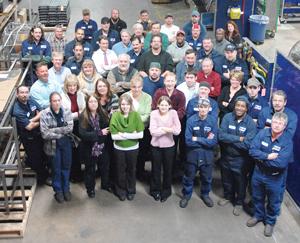
Figure 1Finding enough room for a group photo is not that big of a deal at General MetalWorks, Mequon, Wis. Elimination of excess raw material inventory and racks of work-in-process hascleared plenty of floor space for such an event. Photos by Lila Aryan Photography.
Waste is not tolerated at General MetalWorks (GenMet), Mequon, Wis. That includes waste related to transportation, processing, inventory, and production, as well as underutilizing people's talents.
A tour of the facility reflects the focus on eliminating waste: The 43,000-square-foot facility that exists today is not the same facility Eric and Mary Isbister purchased 10 years ago.
The aisles are open and not cluttered with work-in-process (see Figure 1). Gone are the racks of raw material. The facility hasn't had a full-time forklift driver in eight years; everything is moved on fabricated carts or used grocery carts.
Manufacturing flows naturally. Material is delivered in the rear and moved to raw material storage towers connected to laser cutting machines or a laser/punch combination machine. Once cut, the material moves to forming and then welding, in the front of the shop. When completely fabricated, parts are moved from welding, which is right next to shipping, where they are packed and ready for delivery.
"In a perfect world, material is delivered on day one, cut on day one, formed and welded on day one or day two, and shipped out soon afterward," Eric Isbister said.
Nothing's perfect, but GenMet's commitment to lean manufacturing, quality control, and employee training has helped the company survive 2009 without any layoffs or wage freezes. In fact, even with revenue decreasing to $10 million in 2009 from $12.6 million in 2008, the company is more than ready to take on new endeavors, such as pursuing business in the alternative-energy fields. Its finished goods inventory is at an all-time low, approximately $3,000 worth compared to $100,000 only a few years ago. It can deliver prototypes, from concept to sample, in 48 hours. Employee productivity has doubled, and lead-time for fabricated parts has been cut in half to a couple of weeks.
GenMet is poised to take advantage of a rebounding economy. For its efforts to be in this position and the dramatic changes it has made over the years, the company is the winner of The FABRICATOR's 2010 Industry Award.
Getting Started
Eric Isbister didn't start out as a metal fabricator, but he was a builder of sorts. He spent 21 years on the East Coast building nuclear submarines for Electric Boat Division of General Dynamics, Groton, Conn. The end of the Cold War, however, shrunk the market for those peacekeeping products.
A new job led him to Wisconsin, but it didn't float his boat like submarine building. In 1998 he started looking for a manufacturing business.
Around that time General MetalWorks went up for sale. The company, originally known as Biersach & Niedermeyer Co., had survived the great Chicago fire in 1871 and a relocation to the Milwaukee area afterward, but was having a hard time making a go of it toward the end of the last century. The fourth generation of family ownership sold the metal fabricating business to a new owner, who ultimately sold it as well. An unfortunate event for him, however, proved fortuitous for the Isbisters.

Figure 2The lean environment at GenMet creates an environment where producing 10 battery boxes for a military vehicle makes more sense than making 100 of them and placing the excess in inventory until the next customer order arrives.
Eric purchased the business, and his wife, Mary, a 10-year veteran of the research division of Pfizer Inc., soon joined him. Mary brought organizational development experience to the company, which helped to transform the company further. The business that existed at the time of the purchase certainly is different today.
"Everything needed a skid, and everything needed a forklift," Eric recalled.
That's changed dramatically in recent years as the company has worked with the Wisconsin Manufacturing Extension Partnership in lean training initiatives and made investments in technology and its work force. In fact, the previous owners would be hard-pressed to recognize the business. Only the Swiss chalet facade of the building is the same as when it was built in 1972.
Changing the Shop Floor
So where did all the raw material storage go? For starters, most material isn't delivered until it's needed. Typically, that's no more than two days before a job starts, according to Mary. When it's delivered, the material heads for the towers.
The first tower is a 16-shelf automated storage and retrieval system attached to two 4-kW laser cutting machines that are capable of running unattended. The two 3015 LVP-40CFX Mitsubishi machines, which have 60- by 120-inch beds, can cut mild steel up to 0.625 in., stainless steel up to 0.5 in., and aluminum up to 0.5 in. Cutting material 0.5 in. thick or less typically comprises the majority of GenMet's fabricating business, Eric said.
This automated setup is GenMet's third generation of automated laser cutting. The 2-year-old machines cut twice as fast as the previous-generation laser cutting machines that were replaced, and they have given the company the ability to take on jobs that have tighter tolerances. Eric said that the laser cutting technology improves at such a rapid pace that GenMet likely will upgrade again in the coming years.
The second tower is a 10-shelf unit attached to a Finn-Power LP laser/punch combination machine. The 3-year-old machine tool has a 2.5-kW resonator and a 20-station turret. It can accommodate a sheet as large as 60 by 120 in. and handle mild and stainless steel up to 0.14 in. and aluminum up to 0.19 in.
The laser/punch combo also comes with an unloading robot and three trap doors, through which smaller parts can be dropped into wooden boxes. Eric admitted that the process of automated unloading and separating several different parts still requires operator intervention.
"That's the nut that people haven't cracked yet," he said.
Once material leaves either the laser cutting machines or the laser/punch combo, it makes its way via carts in most instances to the forming department in the middle of the shop floor. The just-in-time nature of daily manufacturing schedules (see Figure 2) keeps parts moving quickly through the shop so that jobs can be shipped on time to customers.
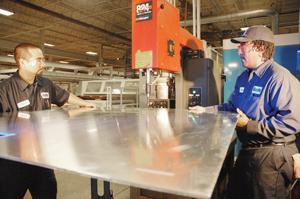
Figure 3GenMet employees fabricated a stabilizing table to help with the handling of large parts at the hardware insertion station. Such suggestions have led to increased shop floor productivity.
The forming department has seven press brakes, the largest of which is 220 tons and 13 feet long. Two newer Cincinnati press brakes, a 90-ton and a 135-ton, really have stood out as productivity enhancers.
GenMet purchased the press brakes after employees pushed for and justified the purchase. The employees, who got the idea after a companywide outing to a major metal fabricating tradeshow, believed modern press brakes and hardened, precision-ground tooling would lead to quick throughput times in the forming department. Setup on the older press brakes was taking longer than it should because operators had to use paper shims to align the older tooling. Once the new press brakes were installed and tooling put into operation, the team quickly learned they made the right decision.
Setup time, the time between the setup of the press brake for a job to the production of the first good-quality part, dropped from an average of 45 minutes to just under 10 minutes. In addition, scrapped setup pieces were virtually eliminated.
That type of employee suggestion is not unusual (see Figure 3). GenMet strives to create an environment that encourages employees to offer suggestions and criticism, all of which hopefully contributes to better productivity.
"It's all about making everyone have a say, so they can affect their own destinies," Mary said.
A 4- by 8-ft. shop floor bulletin board, covered with charts and graphs generated by the company's JobBOSS ERP system, is a reflection of these motivated employees. These graphs detail every aspect of the business that directly impacts overall business profitability and, subsequently, potential bonus compensation. (That bulletin board material is really the only paper that GenMet generates on the shop floor because it uses 50 computers instead of paper routing slips to update everyone on jobs and work schedules.) The "dashboard," as Eric described it, has daily, monthly, and year-to-date sales numbers; accepted orders sorted by customer and lead-time; a ratio of sales dollars to actual products being built; on-time delivery statistics; and accident reports. No one is in the dark in terms of what needs to be accomplished to improve the company's overall profitability.
Stepping up Quality Efforts
This team environment has become evident during the last four years or so. During that time some poor performers have left, but more important, the company went through ISO 9001 certification. Eric called the certification effort "a process to cleanse the company."
Many people think ISO certification is just an effort to create mounds of paperwork. However, that paperwork is linked to the creation of procedures that can be followed repeatedly to eliminate variability—or the potential for mistakes—in processes. Truthfully, the latest ISO revision allows the company to decide just how much documentation it needs and focuses on continuous improvement.
The "management system," as ISO advocates like to call it, also calls for analysis of processes so that bad habits don't become part of a documented process. Metrics are established for a process and tracked.
Eric reflected on the initial meetings with the ISO certification consultant and smiled because of just how little he offered in those early meetings. He said the consultant tried to say as little as possible, forcing employees to fill in gaps and participate. Before you knew it, leaders emerged, and they led the continuous improvement efforts on the shop floor.
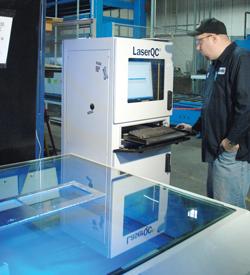
Figure 4Several years ago GenMet employees had to wait on the company's only quality inspector to sign off on production of first pieces. Now they can use a laser scanner that sits right in the middle of the shop floor to ensure parts meet all specifications—without waiting for someone.
For example, the team decided that a laser inspection machine made sense for the shop floor. All first-piece parts for all new jobs or jobs involving a new operator must be inspected and given a blue tag before any other fabricating can take place. In the past when a part needed to be scanned to check critical tolerances, employees had to take it to the front of the building to use a stationary coordinate measuring machine or find the company's portable unit. Finally, the company decided to purchase a Virtek LaserQC® 2-D laser inspection machine, which it also uses to perform statistical process control measurements and reverse engineering (see Figure 4). No one has to wait to get the detailed quality check he needs. The machine has proven so useful that GenMet has just received a second one capable of 3-D inspections.
And no one is waiting on quality inspectors either. Mary said that 30 percent of the company's shop floor employees are "quality-at-the-source" inspectors, capable of delivering that blue tag when needed (see Figure 5).
GenMet has come a long way since the days when the quality manager had to perform all of the quality checks. Nowadays the quality manager, Chuck Minor, leads the effort to teach quality skills to everyone. In fact, he has spearheaded the creation of a blueprint-reading class. The class covers everything from general part tolerances to weld symbols.
Constant Training
The training doesn't stop with blueprint reading.
GenMet just went through its third shop floor lean manufacturing training program. Eric said it makes sense to repeat the training every two or three years for new people and to remind people what they learned, to keep them always thinking about eliminating non-value-added activities, the waste no one wants to see.
To help with those waste-identifying efforts, GenMet also sent 10 individuals to lean leader training, where they worked on the personal interaction skills that can help them sell lean concepts to their co-workers and encourage more participation. That keeps the lean spirit alive even when formal training programs aren't in session.
The further development of skills is highly encouraged at GenMet. The company actually uses a skills matrix that tracks an employee's training. By consulting the matrix at employee performance review time, company management can determine just how valuable the employee is to helping the company meet its goals. Management also can see just what future training initiatives make sense for that employee.
"People know that we've gone from a $3 million to a $12.6 million company, and they know that they have to do more today than yesterday or the Chinese or Indians will win more business," Eric said.
Preparing for the Future
All of this effort to eliminate waste and improve quality probably was more evident during 2009 than it might have been in GenMet's record-setting year in 2008. Top-line revenue is down, but the company has retained a very similar gross profit as in 2008.
From a strategic point of view, GenMet has never been in a stronger position. It ships about 99 percent defect-free parts on time and works hard to shrink lead-times (see Figure 6).
Better yet, the Isbisters don't have to lead the charge for continuous improvement. Leaders have emerged (see Figure 7) from the company's work force of 65, and they now are acting as the waste-watchers.
That leaves company management to focus on new business opportunities. GenMet actually hosted a Spanish wind turbine OEM recently and has fabricated its first parts for a Danish wind energy firm. The company made its first parts for a customer in the commercial art arena and hopes to expand that relationship as the customer expands its own efforts in the metal art and sculpture field. GenMet has joined four local machining companies in an effort to market their combined capabilities; the group has submitted several quotes, one of which is for a large military truck manufacturer.
While so many companies focused on survival in 2009, GenMet looked to the future. The hard work of the past several years has paid off. Winning companies don't waste anything, including an economic downturn.
What makes for an Industry Award winner?
The winner of The FABRICATOR's 2010 Industry Award was judged in three categories: operational improvements, business success, and contributions to the community. Entrants were asked to detail how their metal fabricating operations have excelled in each of those areas over the last year.
Upon receiving the entries, The FABRICATOR staff pared the list and provided three finalists to its Editorial Advisory Board members, who acted as the final judges. After reading each submission, the judges scored the companies in the three areas, with a maximum of 40 points for operational improvement, 40 points for business success, and 20 points for community involvement. The company scoring the most points was declared the winner.
As part of winning the 2010 Industry Award, General MetalWorks won complimentary registration, travel, and hotel accommodations for The FABRICATOR's Leadership Summit: Metal Matters 2010 conference, March 3-5, at Disney's BoardWalk Resort, in Lake Buena Vista, Fla.
If your company is interested in competing for the 2011 Industry Award, visit www.fmanet.org/ members/industry-award.cfm for more details.
About the Author

Dan Davis
2135 Point Blvd.
Elgin, IL 60123
815-227-8281
Dan Davis is editor-in-chief of The Fabricator, the industry's most widely circulated metal fabricating magazine, and its sister publications, The Tube & Pipe Journal and The Welder. He has been with the publications since April 2002.
subscribe now

The Fabricator is North America's leading magazine for the metal forming and fabricating industry. The magazine delivers the news, technical articles, and case histories that enable fabricators to do their jobs more efficiently. The Fabricator has served the industry since 1970.
start your free subscription- Stay connected from anywhere

Easily access valuable industry resources now with full access to the digital edition of The Fabricator.

Easily access valuable industry resources now with full access to the digital edition of The Welder.

Easily access valuable industry resources now with full access to the digital edition of The Tube and Pipe Journal.
- Podcasting
- Podcast:
- The Fabricator Podcast
- Published:
- 04/16/2024
- Running Time:
- 63:29
In this episode of The Fabricator Podcast, Caleb Chamberlain, co-founder and CEO of OSH Cut, discusses his company’s...
- Trending Articles
AI, machine learning, and the future of metal fabrication

Employee ownership: The best way to ensure engagement

Steel industry reacts to Nucor’s new weekly published HRC price

How to set a press brake backgauge manually

Capturing, recording equipment inspection data for FMEA

- Industry Events
16th Annual Safety Conference
- April 30 - May 1, 2024
- Elgin,
Pipe and Tube Conference
- May 21 - 22, 2024
- Omaha, NE
World-Class Roll Forming Workshop
- June 5 - 6, 2024
- Louisville, KY
Advanced Laser Application Workshop
- June 25 - 27, 2024
- Novi, MI
























